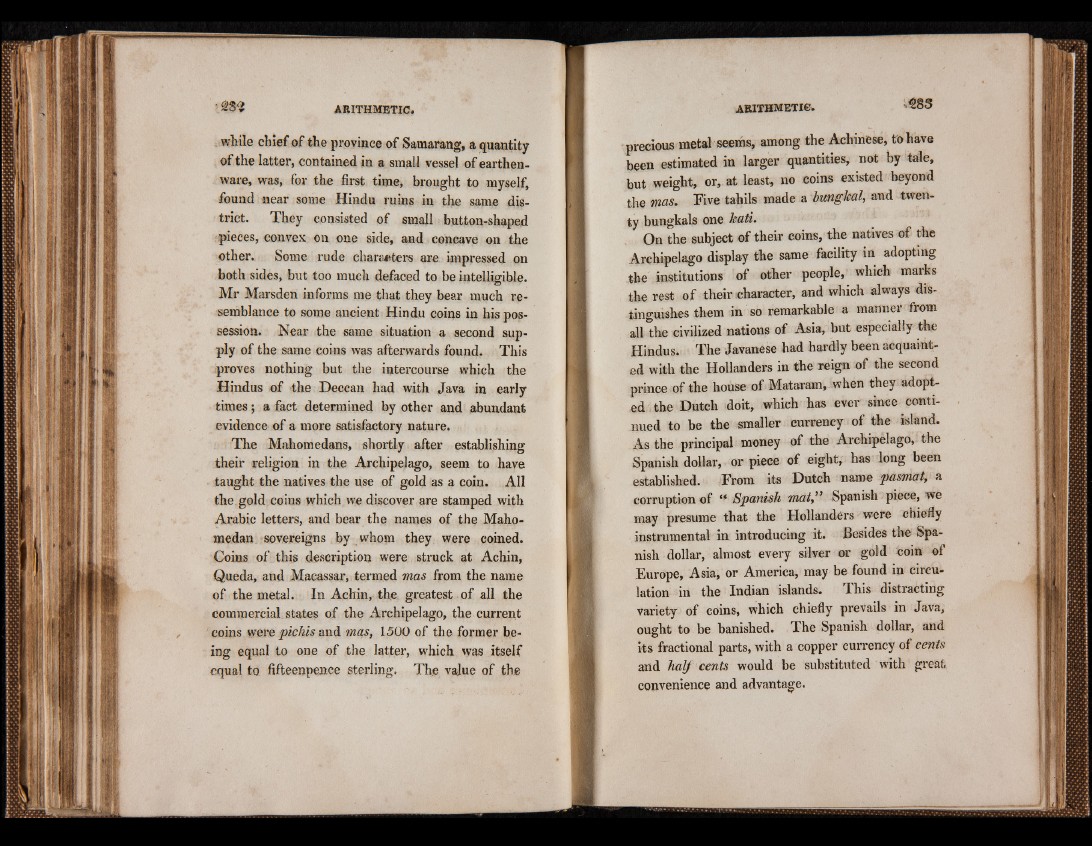
while chief of the province of Samarang, a quantity
of the latter, contained in a small vessel of earthenware,
was, for the first time, brought to myself,
found near some Hindu ruins in the same district.
They consisted of small button-shaped
pieces, convex on one side, and concave on the
other. Some rude characters are impressed on
both sides, but too much defaced to be intelligible.
Mr Marsden informs me that they bear much resemblance
to some ancient Hindu coins in his possession.
Near the same situation a second supply
of the same coins was afterwards found. This
proves nothing but the intercourse which the
Hindus of the Deccan had with Java in early
times; a fact determined by other and abundant
evidence of a more satisfactory nature.
The Mahomedans, shortly after establishing
their religion in the Archipelago, seem to have
taught the natives the use of gold as a coin. All
the gold coins which we discover are stamped with
Arabic letters, and bear the names of the Maho-
medan sovereigns by whom they were coined.
Coins of this description were struck at Achin,
Queda, and Macassar, termed mas from the name
of the metal. In Achin, the greatest of all the
commercial states of the Archipelago, the current
coins were pichis and mas, 1500 of the former being
equal to one of the latter, which was itself
equal to fifteenpence sterling. The value of the
precious metal seems, among the Achinese, to have
been estimated in larger quantities, not by tale,
but weight, or, at least, no coins existed beyond
the mas. Five tabils made a bungkal, and twenty
bungkals one kati.
On the subject of their coins, the natives of the
Archipelago display the same facility in adopting
the institutions of other people, which marks
the rest of their character, and which always distinguishes
them in so remarkable a manner from
all the civilized nations of Asia, but especially the
Hindus. The Javanese had hardly been acquainted
with the Hollanders in the reign of the second
prince of the house of Mataram, when they adopted
the Dutch doit, which has ever since continued
to be the smaller currency of the island.
As the principal money of the Archipelago, the
Spanish dollar, or piece of eight, has long been
established. From its Dutch name pasmat, a
corruption of ‘‘ Spanish mat” Spanish piece, we
may presume that the Hollanders were chiefly
instrumental in introducing it. Besides the Spanish
dollar, almost every silver or gold coin of
Europe, Asia, or America, may be found in circulation
in the Indian islands. This distracting
variety of coins, which chiefly prevails in Java,
ought to be banished. The Spanish dollar, and
its fractional parts, with a copper currency of cents
and halj cents would be substituted with great
convenience and advantage.